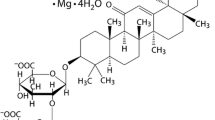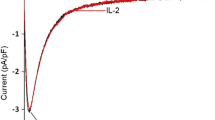Abstract
Recent data show that UD-CG 212 in nanomolar concentrations increases myofibrillar Ca++ responsiveness of chemically skinned cardiac preparations in the presence of elevated inorganic phosphate. We studied the effects of UD-CG 212 on cell shortening of intact myocytes and in addition measured the intracellular calcium transients with the aid of INDO-1 fluorescence in the presence of 5 mM inorganic phosphate.
The validity of our experimental system was first tested with the calcium channel opener Bay k 8644. Bay k 8644 at 10−8 M did not significantly influence myocyte shortening ( + 13.9 ± 4.6%, n = 9) but at 10−7 M and 10−6 M significantly increased contraction by 40.1 +- 13.6%and52.5 ± 17.0% respectively. Bay k 8644 at 10−8 M increased the INDO-1 fluorescence ratio by 17.3 ± 4.7% (P < 0.01; n = 9), and at 10−7 M by 21.5 + 4.3% (P < 0.01; n = 9), whereas 10−6 M Bay k 8644 had no significant effect on peak INDO-1 ratio. However, 10−7and 10−6 M Bay k 8644 accelerated and broadened the calcium transients.
Cell shortening of guinea pig ventricular myocytes electrically stimulated at 1 Hz was significantly increased by UD-CG 212 (10−9-10−7 M) and isoprena line(3 × 10−8 M). An increase of 37.0 ± 14.0% (P < 0.05; n = 9) was observed at 10−9 M UD-CG 212, 90.5±18.2% (P<0.05; n=9) at 10−8 M UD-CG 212, 164.0 ± 34.9% (P < 0.05; n = 9) at 10−7 M UD-CG 212, and 258.2 ± 67.4% (P < 0.05; n = 9) at 3 × 10-8 M isoprenaline. Peak INDO-1 fluorescence ratios were not significantly (P > 0.05) influenced after addition of 10−9 M and 10−8 M UD-CG 212, but significantly increased by 19.4 ± 4.9%(P < 0.05; n = 9) at 10−7 MUD-CG 212 and by 81.1 ± 11.1% (P < 0.05; n = 9) at 3 x 10−8 M isoprenaline.
In conclusion, UD-CG 212 (10−9 - 10−7 M) Concentration-dependently increased myocyte shortening in the presence of 5 mM inorganic phosphate. Low concentrations of 10−9 and 10−8 M UD-CG 212 increased myocyte contractility without altering the peak INDO-1 fluorescence ratio whereas 10−7 M UD-CG 212 and 3 × 10−8 M isoprenaline increased cell shortening as well as peak INDO-1 fluorescence ratio. These data suggest that low concentrations of UD-CG 212 increase myocyte contractility by enhancing myofibrillar calcium responsiveness whereas higher concentrations elevate intracellular calcium probably via increased intracellular CAMP brought about by phosphodiesterase inhibition.
Similar content being viewed by others
References
Allen DG, Morris PG, Orchard CH, Pirolo JS (1985) A nuclear magnetic resonance study of metabolism in the ferret heart during hypoxia and inhibition of glycolysis. J. Physiol 361:185–204
Asanoi H, Ishizaka S, Kameyama T, Ishise H, Sasayama S (1994) Disparate inotropic and lusitropic responses to pimobendan in conscious dogs with tachycardia-induced heart failure. J Cardiovasc Pharmacol 23:268–274
Bethke T, Meyer W, Schmitz W, Scholz H, Stein B, Thomas K, Wenzlaff H (1992) Phosphodiesterase inhibition in ventricular cardiomyocytes from guinea-pig hearts. Br J Pharmacol 107:127–133
Böhm M, Morano I, Pieske B, Ruegg JC, Wankerl M, Zimmermann R, Erdmann E (1991) Contribution of cAMP-phosphodiesterase inhibition and sensitization of the contractile proteins for calcium to the inotropic effect of pimobendan in the failing human myocardium. Circ Res 68:689–701
Brown AM, Kunze DL, Yatani A (1984) The agonist effect of dihydropyridines on Ca channels. Nature 311:570–572
Camacho SA, Figueredo VM, Brandes R, Weiner MW (1993) Calcium-dependent fluorescence transients and phosphate metabolism during low-flow ischemia in rat hearts. Am J Physiol 265:H114-H122
Elliott AC, Smith GL, Eisner DA, Allen DG (1992) Metabolic changes during ischemia and their role in contractile failure in isolated ferret hearts. J Physiol 454:467–490
Endoh M, Shibasaki T, Satoh H, Norota I, Ishihata A (1991) Different mechanisms involved in the positive inotropic effects of benzimidazole derivative UD-CG 115 BS (Pimobendan) and its demethylated metabolite UD-CG 212 Cl in canine ventricular myocardium. J Cardiovasc Pharmacol 17:365–375
Ferroni C, Hano O, Venntura C, Lakatta EG, Klockow M, Spurgeon H, Capogrossi MC (1991) A novel positive inotropic substance enhances contractility without increasing the Ca2+ transient in rat myocardium. J Mol Cell Cardiol 23:325–331
Figueredo VM, Brandes R, Weiner MW, Massie BM, Camacho SA (1992) Cardiac contractile dysfunction during mild coronary flow reductions is due to an altered calcium-pressure relationship in rat hearts. J Clin Invest 90:1794–1802
Fujino K, Sperelakis N, Solaro RJ (1988) Sensitization of dog and guinea pig heart myofilaments to Ca++ activation and the inotropic effects of pimobendan: comparison with milrinone. Circ Res 63:911–922
Hagemeijer F (1993) Calcium sensitization with pimobendan: pharmacology, haemodynamic improvement, and sudden death in patients with chronic congestive heart failure. Eur Heart J 14:551–566
Hagemeijer F, Roth W, Brand HJ (1989) Correlations between the cardiovascular effects of pimobendan and plasma concentrations of the parent compound and its major active metabolite, UD-CG 212 CI, in patients with congestive heart failure. J Cardiovasc Pharmacol 14 [Suppl 2]:S57-S64
Hasenfuss G, Holubarsch C, Heiss HW, Just H (1989) Influence of UD-CG 115 on hemodynamics and myocardial energetics in patients with idiopathic dilated cardiomyopathy. Am Heart J 118:512–519
Herzig JW, Ruegg JC (1977) Myocardial cross-bridge activity and its regulation by Ca++, phosphate, and stretch. In: Riecker G, Weber A, Goodwin J (eds) Myocardial failure. Springer, Berlin Heidelberg New York, pp 41–51
Herzig JW, Peterson JW, Ruegg JC, Solaro RJ (1981) Vanadate and phosphate ions reduce tension and increase cross-bridge kinetics in chemically skinned heart muscle. Biochim Biophys Acta 672:191–196
Hess P, Lansman JB, Tsien RW (1984) Different modes of Ca channel gating behaviour favoured by dihydropyridine Ca agonists and antagonists, Nature 311:538–544
Katz SD, Kubo S, Jessup M, Brozena S, Troha JM, Wahl J, Cohn JC, Sonnenblick EH, LeJemtel T (1992) A multicenter, randomized double-blind, placebo-controlled trial of pimobendan, a new cardiotonic and vasodilator agent, in patients with severe congestive heart failure. Am Heart J 123:95–103
Kentish J (1986) The effects of inorganic phosphate and creatinine phosphate on force production in skinned muscles from rat ventricle. J Physiol (Lond) 370:585–604
Kubo SH, Gollub S, Bourge R, Rahko P, Cobb F, Jessup M, Brozena S, Brodsky M, Kirlin P, Shanes J, Konstam M, Gradman A, Morledge J, Cinquegrani M, Singh S, LeJemtel T, Nicklas J, Troha J, Cohn JC (1992) Beneficial effects of pimobendan on exercise tolerance and quality of life in patients with heart failure. Circulation 85:942–949
Lee JA, Rüegg JC, Allen DG (1989) Effects of pimobendan, a novel inotropic agent, on intracellular calcium and tension in isolated ferret ventricular muscle. Clin Sci 76:609–618
Lues I, Beier N, Jonas R, Klockow M, Haeusler G (1993) The two mechanisms of action of racemic cardiotonic EMD 53998, calcium sensitization and phosphodiesterase inhibition, reside in different enantiomers. J. Cardiovasc Pharmacol 21: 883–892
Mitchell MR, Powell T, Terrar DA, Twist VW (1987) Electrical activity and contraction in cells isolated from rat and guinea pig ventricular muscle: a comparative study. J Physiol 391:527–544
Phillips PJ, Gwathmey JK, Feldman MD, Schoen FJ, Grossman W, Morgan JP (1990) Post-extrasystolic potentiation and the force-frequency relationship: differential augmentation of myocardial contractility in working myocardium from patients with end-stage heart failure. J Mol Cell Cardiol 22:99–110
Rector TS, Cohn JC (1992) Assessment of patient outcome with the Minnesota Living with Heart Failure questionnaire: reliability and validity during a randomized, double-blind, placebo-controlled trial of pimobendan. Am Heart J 124:1017–1025
Remme WJ, Kruijsen DACM, van Hoogenhuyze DCA, Krauss XH, Bartels CL, Storm CJ, de Leeuw PW (1994) Hemodynamic, neurohumoral, and myocardial energetic effects of pimobendan, a novel calcium-sensitizing compound, in patients with mild to moderate heart failure. J Cardiovasc Pharmacol 24:730–739
Rüegg JC (1986) Effects of new inotropic agents on Ca++ sensitivity of contractile proteins. Circulation 73 [Suppl III]:III78-III84
Scheld HH, Fritsche R, Schlepper M, Van Meel JCA (1989) Pimobendan increases calcium sensitivity of skinned human papillary muscle fibers. J Clin Pharmacol 29:360–365
Solaro RJ, Fujino K, Sperelakis N (1989) The positive inotropic effect of pimobendan involves stereospecific increases in the calcium sensitivity of cardiac myofilaments. J Cardiovasc Pharmacol 14 [Suppl 2]:S7-S12
Spurgeon HA, Stern MD, Baartz G, Raffaeli S, Hansford RG, Talo A, Lakatta EG, Capogrossi MC (1990) Simultaneous measurements of Ca2+, contraction and potential in cardiac myocytes. Am J Physiol 258:H574-H586
Spurgeon HA, duBell WH, Stern MD, Solott SJ, Ziman BD, Silverman HS, Capogrossi MC, Talo A, Lakatta EG (1992) Cytosolic calcium and myofilaments in single rat cardiac myocytes achieve a dynamic equilibrium during twitch relaxation. J Physiol 447:83–102
Thomas G, Chung M, Cohen CJ (1985) A dihydropyridine (Bay k 8644) that enhances calcium currents in guinea pig and calf myocardial cells. Circ Res 56:87–96
Van Meel JCA (1987) Effects of some cardiotonic agents on contractility of skinned fibers from mammalian heart. Arzneim Forsch/Drug Res 37:679–682
Van Meel JCA, Entzeroth M, Redemann N, Haigh RM (1995) Effects of pimobendan and its metabolite on myofibrillar calcium responsiveness and ATPase activity in the presence of inorganic phosphate. Arzneim Forsch/Drug Res 45:136–141
Webster KA, Bodi I, McNamara JP, Tracy M, Discher DJ, Bishopric NH (1993) Negative lusitropy and abnormal calcium handling in hypoxic cardiac myocytes exposed to the calcium-sensitizer EMD 53998. J Mol Cell Cardiol 25:747–751
Westfall MV, Wahler GM, Solaro RJ (1993) A highly specific benzimidazole pyridazinone reverses phosphate-induced changes in cardiac myofilament activation. Biochemistry 32:10464–10470
Author information
Authors and Affiliations
Rights and permissions
About this article
Cite this article
van Meel, J.C.A., Redemann, N., Diederen, W. et al. Low concentrations of UD-CG 212 enhance myocyte contractility by an increase in calcium responsiveness in the presence of inorganic phosphate. Naunyn-Schmiedeberg's Arch Pharmacol 351, 644–650 (1995). https://doi.org/10.1007/BF00170165
Received:
Accepted:
Issue Date:
DOI: https://doi.org/10.1007/BF00170165




